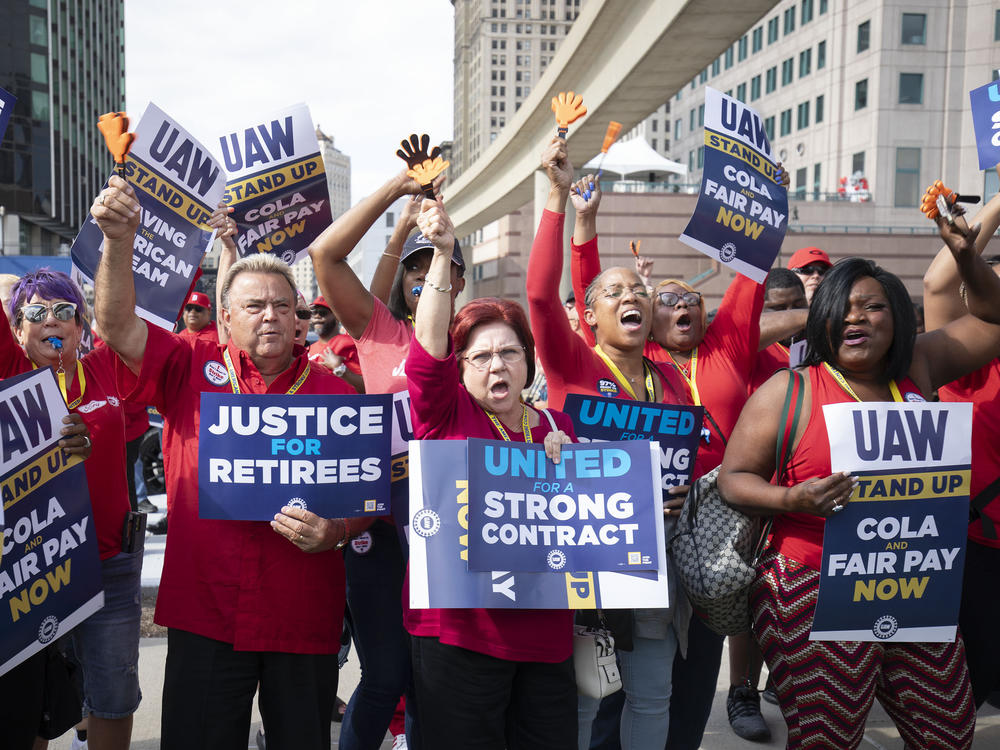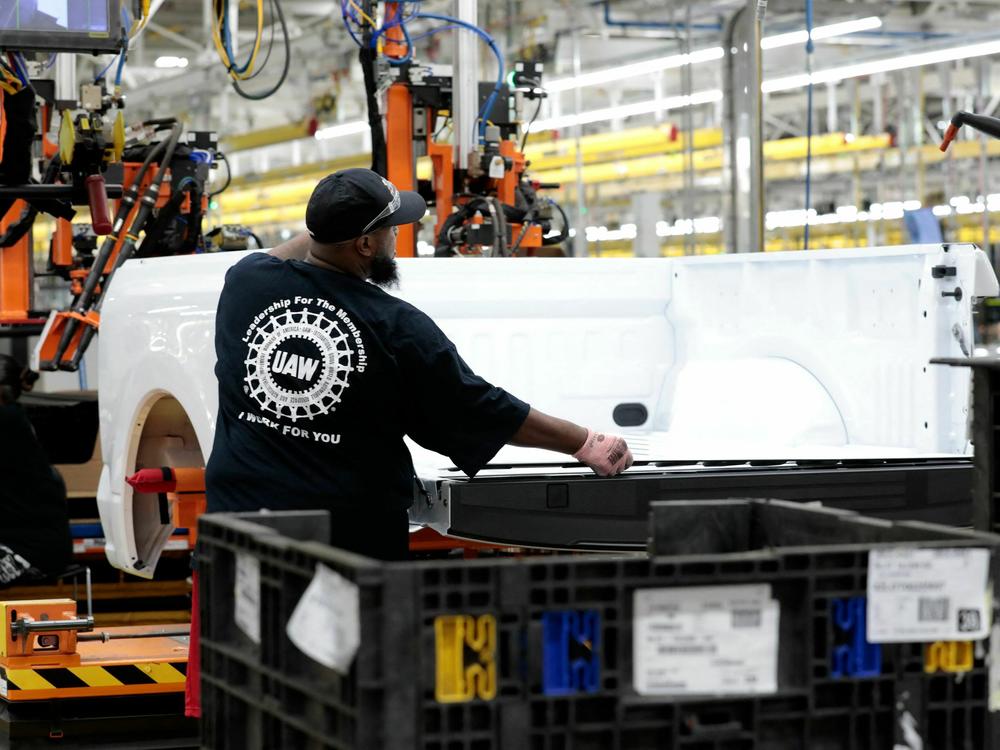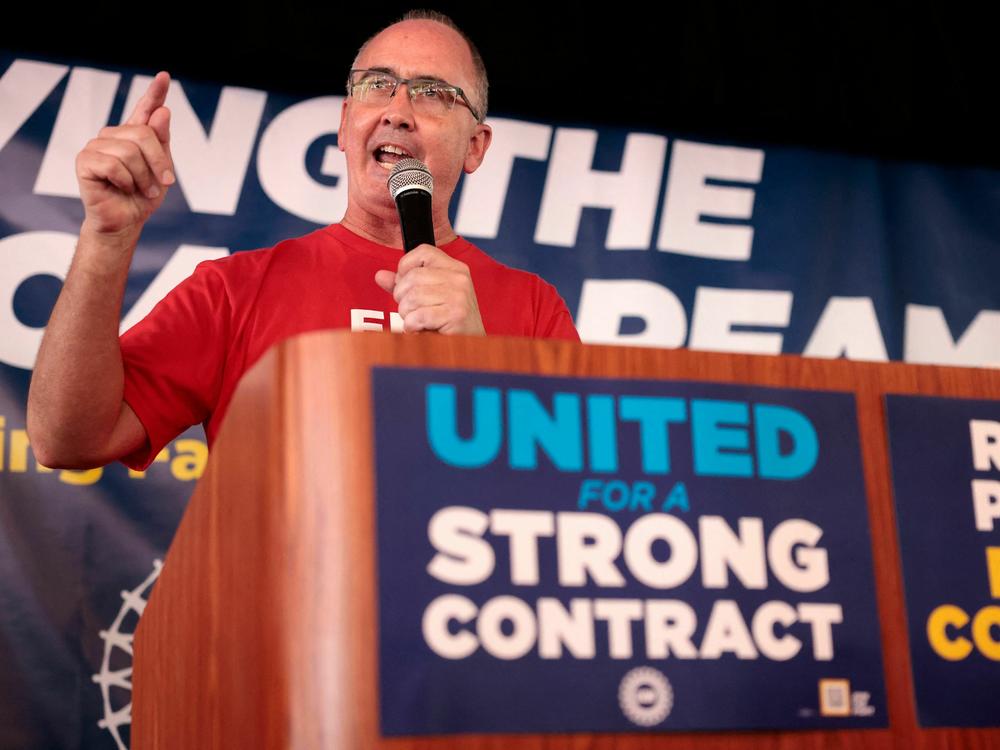Section Branding
Header Content
The UAW won big in the auto strike — but what does it mean for the rest of us?
Primary Content
The United Auto Workers staged an unprecedented strike against the Big Three Detroit automakers — and they emerged with three big, lucrative deals. But the wider impact on the rest of the country is much less clear.
Those contracts will clearly benefit UAW workers. If ratified by members, the new contracts would lock in raises in wages of at least 25% — and for some temps of as much as 168% — as well as boost retirement contributions and other benefits.
But here's what these contracts means for car buyers and the economy — and also Tesla.
UAW workers
For the approximately 150,000 workers covered by these contracts, these deals are, obviously, a big deal. (Workers are currently voting on whether to ratify the contracts, or push for even better.)
In these talks, the UAW was determined to make up for all the pay and benefits members gave up in years past, and to make a job at a unionized auto plant once again a ticket for a for a secure, middle-class lifestyle.
And many workers — though not all — believe the deals will provide just that.
"It's going to be able to change the trajectory of my life," says Brandon Bell, a worker at Ford's Michigan Assembly Plant who will see his hourly pay go from $20 to $35 by this December if the contract is ratified.
"All the prices and cost of living has gone up so much. I don't have to worry about it as much now," he added.
Auto companies and suppliers
Gone are the days when the Big Three automakers dominated the U.S. market. These new contracts will push up labor costs significantly for companies that already spend much more on their workers than their non-unionized rivals.
That is a significant disadvantage in a fiercely competitive industry.
On the other hand, Detroit automakers knew coming into these strikes that they'd need to pay their workers more. Pay has not kept pace with inflation, and labor costs are rising everywhere.
"It certainly is a disadvantage," argues Tom Narayan, an analyst at RBC Capital, "but I actually don't think this is going to be as painful as many kind of are speculating that it will be."
It's a headwind, he says, but not a "death knell."
After the deals were struck, Ford and Stellantis have both told investors they're confident about their future profits.
Meanwhile, the union's wage gains will indirectly affect non-unionized companies, too, by pressuring them to raise their pay.
That includes non-unionized assembly plants, but also the suppliers who sell parts to those plants, says Ann Marie Uetz, a lawyer who works with lots of automotive suppliers.
"It's a super tight labor market right now — very tough to get skilled labor," Uetz says. Now workers are eying the UAW's big raises, "and so those skilled trades are going to be looking at their employers in the supply base and saying, 'Pay me more.'"
That will ultimately ripple up to the automakers — unionized and otherwise — in the form of higher costs for components.
Car shoppers
Higher pay for auto workers means higher costs for the Big Three automakers, and those costs will need to be absorbed somewhere.
Ford has indicated that the new deal will eventually add $850-900 to the cost of making each of its vehicles.
Analysts, though, caution it won't be easy to raise prices further at a time when car prices have already surged.
"Consumers will bear some of the cost burden over time, but given that affordability is already a challenge for the market, the automakers will not have an easy time passing along all of the costs to buyers," writes Jonathan Smoke, the chief economist at Cox.
New car prices rose 30% after the pandemic started. The average new vehicle is now close to $50,000.
That increase was driven by supply and demand, and by automakers' decisions to focus on building more of their higher-end vehicles, not by labor costs or any other costs. And just as prices have stabilized and even started to fall, interest rates are rising, which makes it more expensive to finance a vehicle ... and harder for companies to raise prices.
Another option: They could cut their expenses elsewhere to make up for added labor costs.
Or, the union always notes, they could just accept a smaller profit — although for the companies that would be be the option of last resort.
The broader economy
The deals will inject a lot of money into the communities around UAW auto plants — just in time for the holidays, Cox economist Jonathan Smoke notes.
They will also push up wages, both in the auto industry and other sectors, through competitive pressure.
Of course, the downside is that rising wages and any increase in auto prices would put upward pressure on inflation, complicating the Fed's fight for an economic soft landing.
Some analysts have also cautioned that the lucrative deals for the UAW could backfire — by being so rich that it creates an incentive for companies to shift assembly jobs to other locations, like Canada or Mexico, or invest even more in automation.
The calculations aren't simple, notes S&P Global Mobility's Michael Robinet. "Every time a vehicle manufacturer and or supplier evaluates whether they want to make a vehicle or a component," he says. "there's lots of factors that work into it."
Labor cost is not the only factor — but it's one of them.
Patty Ellison, a former Stellantis assembly line worker who now works at a Mopar parts warehouse in Michigan, says she's not worried that the contract will shift more jobs to other countries or to robots.
"That's something that we've all dealt with in the automotive industry for forever, basically," she said. "It's just the nature of the business."
The UAW's power
The UAW's fiery, ambitious new president, Shawn Fain, has framed talks with the automakers as a war between the working class and the billionaire class. And these eye-catching new contracts were just the first volley.
The next battle? Expanding, by organizing foreign automakers as well as the disruptive U.S. automaker that dominates the growing EV sector — Tesla.
In terms of foreign automakers, a lot of these efforts will be concentrated in the South.
Detroit may still be known as the Motor City, but since the '80s, the South has attracted more than a dozen assembly plants from foreign automakers like BMW and Hyundai, employing tens of thousands of workers.
Most of them are not unionized — and changing that will be a big challenge.
The UAW has a long history of failure to unionize new plants. It didn't help that for years it was trying to organize plants while also grappling with a corruption scandal that sent several of its leaders to prison for embezzlement and accepting bribes from companies.
The union has made big pushes in the South before, at Mercedes in Alabama, Volkswagen in Tennessee and Nissan in Mississippi.
"There was a lot of money spent, and there was a lot of effort. But they went 0-for-3," says Stephen Silvia, who wrote a book about the UAW's attempts to organize in the South, where right-to-work laws and anti-union political leaders are major obstacles.
The UAW is hoping that the wind is at its back this time. After all, it has just secured record contracts for its members. It's got new leadership. Other unions are also scoring big wins in an economy that gives more leverage to workers. And broader public support for unions is higher than it's been in years.
And even if the UAW fails to unionize other foreign automakers, the workers at those companies could benefit nonetheless.
Automakers have an incentive to keep their pay high enough to dissuade a union push in their plants. Already, Toyota has given its U.S. autoworkers a 9% pay raise since the UAW struck a deal.
Fain nodded to those raises, telling Toyota workers the UAW stands for "U Are Welcome."
Tesla
But of all the potential UAW targets, perhaps none would be more more attractive than unionizing Tesla.
Here, too, the union has previously tried hard and fallen short.
Tesla's first assembly plant, in Fremont, Calif., is far from the right-to-work South, but repeated unionization pushes still failed to gain traction.
There are several factors. Tesla staff, including assembly line workers, get stock options, which is highly unusual in the auto industry.
That stock can be volatile — Tesla shares had a terrible 2022 — but can also be incredibly lucrative. An employee who held Tesla stock for the last five years has seen its value increase 191%. That makes it hard to compare Tesla's compensation to other automakers.
Elon Musk is personally opposed to the UAW, which he says destroys productivity. He has also accused the union of betraying and embezzling from workers, a reference to the corruption of former UAW leaders.
And Tesla has dissuaded unionization, through legal methods as well as those deemed illegal.
For now, these contracts give Tesla an even greater cost advantage as the legacy automakers embark an a high-stakes effort to scale up their EV production and catch up with Tesla's lead.
Stephen Bisaha of the Gulf States Newsroom contributed to this report.
Copyright 2023 NPR. To see more, visit https://www.npr.org.



